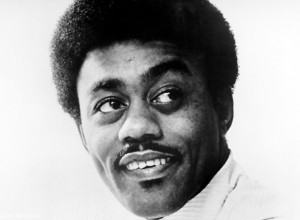A little over a year ago I wrote about Jimmy Hughes who recorded a single called “Steal Away” in 1964. It turned out to be a very important record. Not only was it a Top 20 hit on the Pop chart, it was an early hit for Rick Hall’s FAME label, and a template for the Muscle Shoals sound that would be the catalyst for so many great records.
“Steal Away” was written by Hughes, and it was based, at least in part, on the gospel song “Steal Away to Jesus. This week I want to take another look at the song, but a very different version of it that was released by Johnnie Taylor on the Stax record label in 1970. The versions are so different that when I first heard Taylor’s version I didn’t even recognize it as the Hughes song.
Taylor was born in Crawfordsville, AR in 1934, and he grew up in nearby West Memphis. He sang in church as a child, and when his family moved to Kansas City he joined a gospel group called the Melody Kings. The Melody Kings worked the same gospel circuit as the Soul Stirrers, which enabled Taylor to meet Sam Cooke. Eventually Taylor moved to Chicago where he turned to secular music and joined a doo wop group called the Five Echoes.
An opening in the Highway Q.C.’s brought Taylor back to gospel, in a group that Cooke had been a member of at one time. When Cooke left the Soul Stirrers for the pop world in 1957, Taylor followed him again, taking Cooke’s place as the group’s lead singer. Unfortunately the Soul Stirrers couldn’t retain the momentum they had with Cooke. Taylor stayed for four years before he followed Cooke once again, this time becoming the first artist to sign with Cooke’s SAR Records label.
Taylor had some minor hits for the label including “Rome (Wasn’t Built in a Day).” When Cooke was shot to death in 1964, the label folded, and Taylor was on his own. The lack of a record deal didn’t last long though. By the following year Taylor had moved to Memphis, and signed with Stax. Once again Taylor was only able to score minor hits with records like “I Got to Love Somebody’s Baby,” “Somebody’s Sleeping in My Bed,” and “Next Time.”
The breakthrough for Taylor finally came in 1968 with the massive hit “Who’s Making Love,” a record that went to #1 on the R&B chart, and crossed over to the Top 5 on the Pop chart. The hits didn’t stop there, as Taylor followed his big hit with successful records like “Take Care of Your Homework,” “Jody’s Got Your Girl and Gone,” “I Am Somebody,” and “Steal Away.”
By 1973, Taylor had changed gears considerably. He went from being a deep soul shouter to a smooth crooner. The move paid off big time as Taylor had big hits with the ballads “I Believe in You (You Believe in Me)” and “Cheaper to Keep Her.” In 1975 Stax went out of business and Taylor was on the move again.
Columbia Records became Taylor’s new home. By then the disco era was in full bloom and Taylor bit into it in a big way with his first release for Columbia. “Disco Lady” was Taylor’s first and only #1 Pop hit. Columbia, as you might imagine, wanted more, and Taylor gave them more despite the fact that he didn’t feel comfortable as a disco singer. None of the subsequent records in the genre had the same kind of success as that seen with “Disco Lady.”
By 1982 Taylor had left Columbia for the smaller Beverly Glen label. “What About My Love,” saw some modest success on the R&B chart, but Taylor was looking for a label that was more like Stax and he departed Beverly Glen for Malaco Records, a southern label that was all about soul and blues. It turned out to be a great relationship for both parties. Taylor ended up recording 12 albums during the 15 years he was with the label, and he was one of Malaco’s best selling artists.
Taylor continued touring in the ’80s and ’90s, and managed to score a few R&B hits, albeit small ones. His sound had become something of a hybrid of soul and blues, and in 1996 he released Good Love! an album that reached the top of the Blues chart. His last album Gotta Get the Groove Back, was released in 1999. On May 31, 2000, Johnnie Taylor had a heart attack at his home in Texas and was taken to the hospital, where he died.






Comments